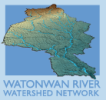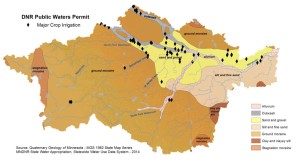ISSUES
Project partners have been meeting and talking to citizens across the Watonwan River Watershed and the following concerns have been raised most commonly. If you have a water quality or quantity issue that you’d like to discuss, please contact us. Click here and learn more about watershed issues by exploring the Interactive Story Map.
River Flow
River flow is increasing in the Watonwan River. Many residents noted a more “flashy” river rising and falling more quickly than historically. Minnesota Department of Natural Resources Researchers measure channel change and river flow and are learning about how the river is changing over time. They assess the channel conditions and how that relates to fish and water quality. Researchers have noted increasing flows and channel widening across the watershed. More water flow carries more pollutants from the landscape.
Channel Change and Rivers Widening
Many residents told stories of rivers widening and channels changing significantly over their lifetime. One recalled in their youth, 50 years ago, being able to jump across a tributary to the Watonwan River. Now it is over 24 feet across. As rivers widen, stream channels change and one response is for pools to get filled in with sediment and riffles buried. These stream features are important for fish habitat. The animation below depicts how changes in flow result in unstable river conditions.
Channel Straightening
River channels across the watershed have been straightened over time. The Channel Change Animation below is based on aerial photos from 1938-2015 in the Watonwan River Watershed.
Changing flows and river channels are filling pools and covering riffles, key habitat for fish and other aquatic organisms. Local anglers have expressed concern noticing less pools available for fishing. As rivers widen, they sometimes impact infrastructure such as roads and bridges. Homes atop river bluffs of the Watonwan River have also been threatened.
Greening Lakes
Many lakes across the watershed are turning green in the summer. Pungent green lakes are usually blooming with algae. Algae are simple, small aquatic plants. An algal bloom is a dense concentration of these plants. Like grass and trees, algae use sunlight, carbon dioxide, and nutrients to generate energy and produce more algae. In most lakes, algal growth is limited by the availability of the nutrients, nitrogen (N) and phosphorus (P). For more information: http://www.shorelandmanagement.org/quick/wq.html
Did you know?
Less than half a pinhead of phosphorus per gallon of water, a phenomenally tiny quantity, is enough to turn a lake bright green.


